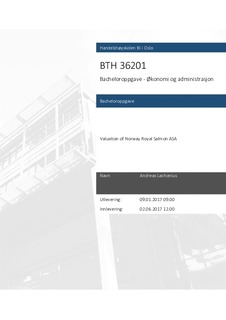Valuation of Norway Royal Salmon ASA
Abstract
In this bachelor thesis, I have performed a valuation of Norwegian Royal Salmon
ASA (NRS).
The problem statement in the thesis is defined as:
‹‹What is the fundamental value of a share in NRS, traded at the Oslo
Stock Exchange as of 23.05.2017››?
With a sub-problem statement:
‹‹Should the fictive investor buy, remain neutral, or sell the NRS stock
when his objective is financial profit››?
The valuation is built of many different analyzes. The first step was to analyze the
financial statement of the firm and to compare historical key figures of NRS and
an industry benchmark. This was done to gain a better understanding of the firm’s
current financial position. The second analysis I performed was a profound
strategic analysis, which consisted of both internal and external aspects of the
firm. A good strategic analysis of macro-economic factors, and potential
competitive advantages is essential in order to understand the firm’s ability, and
possibilities, to grow in the future.
Based on the financial statement analysis and the strategic analysis, I started to
forecast the next ten years for the company. I chose a period of 10 years to avoid
undervaluing the firm, which is a common result in a valuation of cyclical
companies if the forecast period is shorter.
The main valuation approach in this thesis is the discounted cash flow (DCF)
analysis. The forecasted variables serve as inputs in the DCF model. Due to the
high uncertainty tied to the value estimate derived from the model, I have also
used relative valuation as a control method. Once the valuation was performed, I
conducted different simulations and sensitivity analyzes to see what happens with
the share price when selected variables in the DCF model are changed.
As an answer to the problem statement, I have concluded that the NRS stock is
currently undervalued in the market in relation to its fundamental value, which
results in a buy recommendation to the fictive investor.
Description
Bacheloroppgave i Økonomi og administrasjon fra Handelshøyskolen BI, 2017
